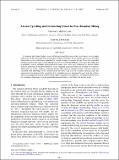| dc.contributor.author | McDougall, Trevor J. | |
| dc.contributor.author | Ferrari, Raffaele | |
| dc.date.accessioned | 2017-09-13T15:53:39Z | |
| dc.date.available | 2017-09-13T15:53:39Z | |
| dc.date.issued | 2017-01 | |
| dc.date.submitted | 2016-04 | |
| dc.identifier.issn | 0022-3670 | |
| dc.identifier.issn | 1520-0485 | |
| dc.identifier.uri | http://hdl.handle.net/1721.1/111191 | |
| dc.description.abstract | A buoyancy and volume budget analysis of bottom-intensified mixing in the abyssal ocean reveals simple expressions for the strong upwelling in very thin continental boundary layers and the interior near-boundary downwelling in the stratified ocean interior. For a given amount of Antarctic Bottom Water that is upwelled through neutral density surfaces in the abyssal ocean (between 2000 and 5000 m), up to 5 times this volume flux is upwelled in narrow, turbulent, sloping bottom boundary layers, while up to 4 times the net upward volume transport of Bottom Water flows downward across isopycnals in the near-boundary stratified ocean interior. These ratios are a direct result of a buoyancy budget with respect to buoyancy surfaces, and these ratios are calculated from knowledge of the stratification in the abyss along with the assumed e-folding height that characterizes the decrease of the magnitude of the turbulent diapycnal buoyancy flux away from the seafloor. These strong diapycnal upward and downward volume transports are confined to a few hundred kilometers of the continental boundaries, with no appreciable diapycnal motion in the bulk of the interior ocean. | en_US |
| dc.description.sponsorship | National Science Foundation (U.S.) (Grant OCE-1233832) | en_US |
| dc.language.iso | en_US | |
| dc.publisher | American Meteorological Society | en_US |
| dc.relation.isversionof | http://dx.doi.org/10.1175/jpo-d-16-0082.1 | en_US |
| dc.rights | Article is made available in accordance with the publisher's policy and may be subject to US copyright law. Please refer to the publisher's site for terms of use. | en_US |
| dc.source | American Meteorological Society | en_US |
| dc.title | Abyssal Upwelling and Downwelling Driven by Near-Boundary Mixing | en_US |
| dc.type | Article | en_US |
| dc.identifier.citation | McDougall, Trevor J., and Ferrari, Raffaele. “Abyssal Upwelling and Downwelling Driven by Near-Boundary Mixing.” Journal of Physical Oceanography 47, 2 (February 2017): 261–283 © 2017 American Meteorological Society | en_US |
| dc.contributor.department | Massachusetts Institute of Technology. Department of Earth, Atmospheric, and Planetary Sciences | en_US |
| dc.contributor.mitauthor | Ferrari, Raffaele | |
| dc.relation.journal | Journal of Physical Oceanography | en_US |
| dc.eprint.version | Final published version | en_US |
| dc.type.uri | http://purl.org/eprint/type/JournalArticle | en_US |
| eprint.status | http://purl.org/eprint/status/PeerReviewed | en_US |
| dspace.orderedauthors | McDougall, Trevor J.; Ferrari, Raffaele | en_US |
| dspace.embargo.terms | N | en_US |
| dc.identifier.orcid | https://orcid.org/0000-0002-3736-1956 | |
| mit.license | PUBLISHER_POLICY | en_US |
| mit.metadata.status | Complete | |
